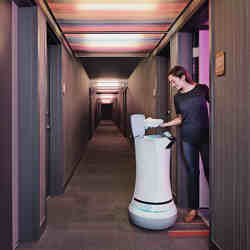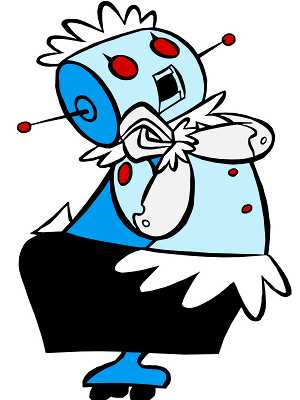
Over the last quarter-century, robots have emerged as a routine part of the business landscape; they manufacture products, pick parts in warehouses, and handle sundry other tasks.
Ongoing advancements in hardware, software, and computing power are ushering in a new era of service robotics, and nowhere is the concept more attractive and viable than in the hospitality industry.
“A hotel is a fascinating environment for a robot,” observes Siddhartha Srinivasa, Finmeccanica associate professor in the Robotics Institute at Carnegie Mellon University. “It has the potential to handle tasks that are cumbersome. It is an apt place to perfect the technology before it is used in the home.”
Using a variety of sensors, including cameras and geolocation technology, robots can tackle a number of rote tasks in hotels, including moving products, supplies, and objects around—and delivering items to guests. Already, a few hotels are experimenting with robots, including the Aloft Cupertino and Aloft Silicon Valley hotels in the U.S., and the Henn-na Hotel in Japan that is scheduled to open in July. The latter will use robots that look like humans—they are dubbed “actroids”—as receptionists and to tuck guests into bed at night. They will also handle traditional hospitality tasks.
Service with a Dial
The idea of robots handling human tasks is nothing new. Science fiction writer Isaac Asimov pondered a future filled with these machines in the 1950s, including his famous series of short stories I, Robot. While robotic devices have already made their mark in manufacturing, medicine, and elsewhere, imbuing systems with human-like characteristics—the ability to see, hear, touch, and interact—is nothing short of daunting. As Srinivasa puts it: “The promise of Rosie the Robot
 from the Jetsons hasn’t been realized yet. But faster and cheaper computing is bringing us closer to the level of autonomy needed to have standalone robots.”
from the Jetsons hasn’t been realized yet. But faster and cheaper computing is bringing us closer to the level of autonomy needed to have standalone robots.”
He points out that code that would have required 20 minutes to run in 1985 now takes about 20 milliseconds. Moreover, faster and better communications protocols mean that some processing, including speech, can now take place in the cloud. All of this, combined with marked improvements in sensors (particularly cameras with much higher megapixel levels) means that “we are finally getting to the point where a robot can respond and react at human speed.” In fact, the “democratization” of sensors—their much lower price points—has “helped build an ecosystem for these systems,” he adds.
One company developing autonomous robots for hotels is Savioke, a Santa Clara, CA firm that has already tested its technology at the Aloft hotels in Silicon Valley. “We have developed a delivery robot that can take things to guests, whether it’s a bag of chips, toothpaste, or a cellphone recharger,” says Adrian Canosa, co-founder and design leader for the company. An attendant at the hotel’s front desk simply loads an item on the three-foot-tall cylindrical device called Relay and it will navigate the hotel (including the elevator) and around humans, using 3D vision. It then phones the guest when it reaches the correct hotel room door. Once the delivery is completed, the robot, which communicates via Wi-Fi and 4G, heads back to the lobby. “It’s designed to provide a delightful experience for guests and staff,” Canosa says.
Delivering on the Concept
For now, Savioke’s Relay handles relatively basic tasks, but Srinivasa and others believe autonomous robots will play a larger role in hotels, hospitals and other locales over the next few years.
One of the challenges is building systems that people perceive as friendly. “The behavior component is critical to whether people accept robots or not,” he explains. This includes mannerisms, speech, words, and visual displays on screens, as well as overall motion. Canosa says Savioke has focused on finding the right balance of interaction with guests and providing a level of politeness that humans demand. “It takes an incredible amount of work and learning to deliver the right level of interaction,” he explains. So far, 95% of guests have rated the robot favorably.
Although autonomous robots remain in the early stages of machine evolution, Srinivasa expects to see a rapid uptick in the technology. In fact, he predicts autonomous robots used in hotels, hospitals, and industrial settings will upload data into the cloud and share experiences so other robots can learn on the fly. Over the next decade, these devices will grow smarter and handle a growing array of functions. Says he: “We already see highly automated technology used for reservations and bookings and this is a logical next step. Although there probably isn’t much of a market for hotels that are staffed only by robots—people still require a human touch—the right use of the technology can benefit both guests and the hotel by delivering a better experience at a lower cost.”
Samuel Greengard is an author and journalist based in West Linn, OR.



Join the Discussion (0)
Become a Member or Sign In to Post a Comment